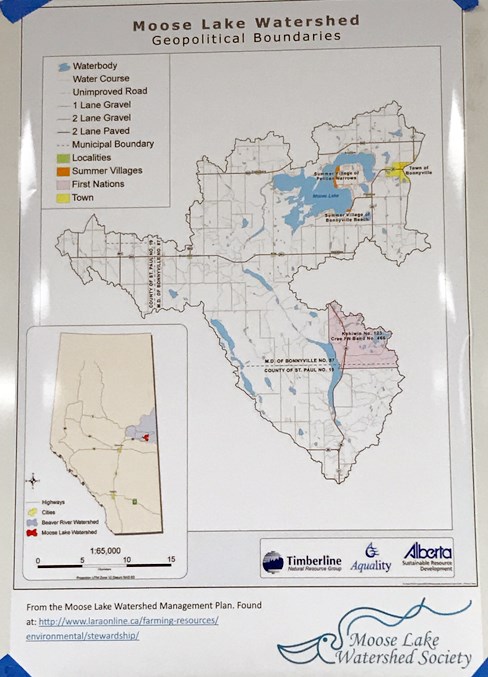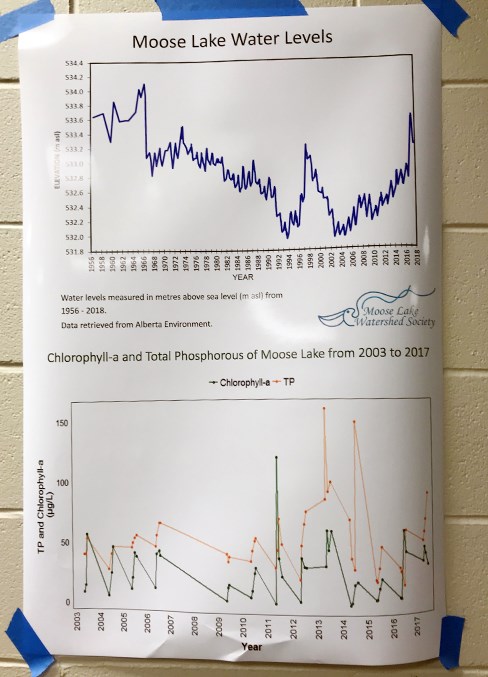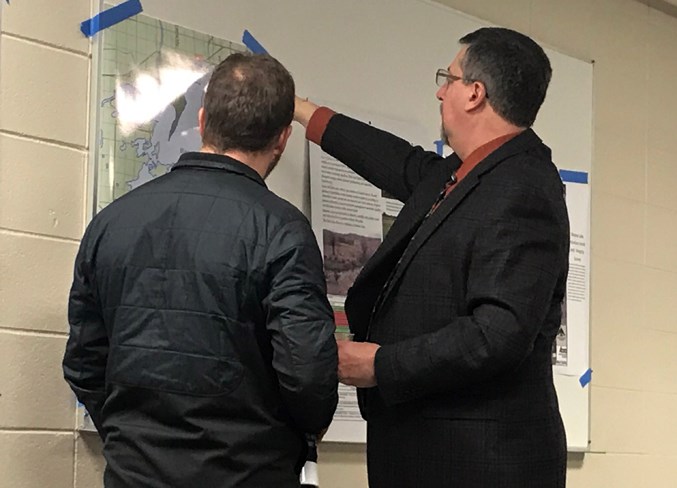Something needs to be done about Moose Lake.
That was the collective agreement between concerned residents, municipal leaders, the Moose Lake Watershed Society (MLWS), and the Lakeland Agricultural Research Association (LARA).
During an open forum on Monday, Oct. 22, the public voiced their opinions on the status of Moose Lake, while discussing their suggestions on how to move forward.
According to MLWS board member Katlyn Macdonald, in order to get the government to address the issue, what they need is support.
“We need those 2,000 people who live on the lake to say there may be a problem on their property and ‘I’m willing to do what it takes to change that.’ That’s what the province wants to see, it’s not necessarily we need 2,000 people to sign membership forms… It’s when we ask for active volunteers and programming, people show up, participate, and be a part of that change. That’s where we need the people.”
 A poster showing the boundaries of the lake.
A poster showing the boundaries of the lake.
She added, “(We need people) present, on the shoreline, doing what they can do on their properties, and properties off of the shoreline realizing everything plays a big part into the whole make-up of the lake. Yes, those (membership) numbers count, but it has to be backing.”
In the past, the province has expressed their lack of support because there weren’t enough people willing to participate in the shoreline cleanups or other volunteer programs.
Kellie Nichiporik, the LARA conservation coordinator and chair of the MLWS, agreed with Macdonald’s statement.
“A lot of times, the government isn’t driven by the science alone. It needs landowners and stakeholders, it needs our lakeshore residents to get involved and get passionate and to make their voices heard,” she exclaimed.
Nichiporik referenced the action taken in order to solve the blue-green algae issues at Pigeon Lake.
“They requested a study done by the government at that time, and we looked at the study, what it was is all the things they could do to treat blue-green algae and then the government gave them recommendations. We asked for that same report to be done on Moose Lake, and what we heard at the time from the provincial government was we didn’t have enough lake residents to show support to have such a study done,” Nichiporik detailed.
She added, although it’s great to see over 1,500 signatures on a petition requesting the government do something about the health of the lake, it’s not enough.
“It’s really good to see the petition and see people wanting action. Our government does need to take notice of that, but we do need the science behind it. Actions alone won’t get us very far. There’s a lot of proposals out there that I’ve heard, unfortunately, our science might not support them. You can’t waste dollars that way, funding is very limited for everybody, and we want to make sure the direction we take in the future is going to get us the most bang for our buck.”
The forum started with a presentation by Nichiporik about the issues the lake is seeing, the tests they have completed so far, and what they still need to do in order to better understand what’s causing the issues at Moose Lake.
Over the years, there have been numerous studies done to get a better idea of the overall health and balance of the lake.
When asked why they can’t try methods other areas have used on their lakes, Nichiporik explained how every lake is different.
“What’s going to be good for one lake won’t be good for another,” she added.
Moose Lake is made-up of several smaller bays, and even those portions of the lake vary.
 Additional posters displayed the varying water levels over the years.
Additional posters displayed the varying water levels over the years.
Franchere Bay and Vezeau for example, tend to stratophy.
“Stratophication is when you get layering in your lake and it’s based on temperature a little bit, but also nutrient content. Certain bays in Moose Lake will get stratophide,” Nichiporik noted. “In the springtime, it usually starts mixing up and mixing the nutrients, and that’s what’s happening in the rest of the lake, but in certain bays it just stays very layered so you get different water quality, different layers, versus the big mixing.”
Through testing, they’re able to determine that Moose Lake is high in nutrients.
Satellite imaging has shown how blue-green algae blooms have formed over the years, with footage dating back to as early as the 1980s.
“It’s a new way of looking at things, and it goes all the way back to 1984, which unfortunately in satellite data isn’t as great as it has been in the last few years. It still gives us a pretty good picture of the overturn over a long-term trend of what our algae has been doing,” Nichiporik expressed.
The MLWS also completed a riparian health survey, in order to determine how healthy these areas are, and what can be done to improve them.
Because the lake is surrounded by agriculture, they decided to construct an off-site watering system. This pulled the livestock away from the water.
Nichiporik explained, “The point of that was to get the cows out of the creek and stopping them from pooping directly into the creek and creating erosion along the shoreline. Now, that riparian area along the river has been repaired.”
Livestock isn’t the only issue. Certain birds and septic systems are also to blame.
This is why Nichiporik would like to purchase a quantitative plate culture (QPC) reader. It would use samples from the lake to determine the fecal DNA in the water.
“If we got our QPC reader, as well as all of the assays that we need, it would probably be about $50,000,” she noted.
With the equipment, MLWS could better understand the make-up of the lake. That way, they could determine the best method moving forward.
Bonnyville Mayor Gene Sobolewski agreed a profile needs to be made because of all of the variables contributing to the issue.
“(Testing) is a way we can identify exactly what’s contributing to the lake. We need to do an import study to know where our phosphorus is coming from. There’s a lot of internal loading,” Nichiporik added. “If we know how much of the nutrients is coming from cows, birds, and septic, that will give us a really good idea of what we can do in the future.”
Human impact such as clear-cutting, removing vegetation, riprap, and sandbags are also contributing factors to the lakes poor health.
Residents suggested constructing a sewer line around the lake for homeowners to tap into, or even treating the water using the Bonnyville Water Treatment Plant, once it’s no longer being used by the town. This method has been utilized in other communities suffering from the same problem.
“You have to do the testing, hire the experts, and work in conjunction with the society, because they have a lot of expertise. Helping and saving costs by purchasing or figuring out how to purchase the equipment so we can run tests ourselves, and be able to get relevant data that we can hand over to an expert to analyze will give us the edge behind it. They can give us recommendations as to whether or not we could utilize the water treatment plant,” emphasized Sobolewski.
Macdonald noted the amount of labour that it took to clear Pigeon Lake.
“I’ve done a lot of studies with Pigeon Lake, and they actually took different approaches to it, because it’s a very different lake than Moose Lake. They’re predominantly made-up of villages that are on sewage line, so that was taken out for them. They did a shoreline restoration and focused more on what they could do on individual lots to try to keep the runoff from further adding nutrients. They changed some of their withdrawal practices, changed some of their shoreline bylaws… they’ve also been doing testing.”
The MLWS hopes that through education, they can have residents working on the impact they have by restricting the use of fertilizers on their property, planting deep-rooting vegetation, and reducing rain runoff through the use of rain barrels.
Nichiporik also recommended reaching out to Bonnyville-Cold Lake MLA Scott Cyr and Lakeland MP Shannon Stubbs.
Finally, the MLWS asked for more support.
“They do measure some of our grants based on population input. When we have meetings like this, this is a really good point as to why we get everybody to sign in,” Macdonald said. “Pigeon Lake had this huge number of people show up to two or three meetings with Alberta Environment present, and they went ‘okay.’”
They hope to hold a similar meeting of their own, and encourage everyone who can attend to do so.



